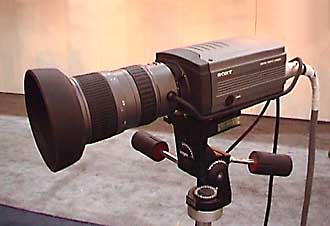
On the face of it, there were fewer new digital products than last year and most of these were integrated into the product lines of each company, rather that appearing as something quite separate.
SONY
Without a doubt, Sony were bullish. Not only were they boasting the number one position in US digital still camera sales with the Digital Mavica® but their DKC-ST5 walked off with the $5,000 and above prize in the Professional Portrait category of the shootout.

The back of the DKC-ST5 is enough to frighten any photographer. The cluster of professional video connectors and large zoom lens clearly show its pedigree is in the broadcast television market, which Sony knows so well.
A thick multi-cored cable connects the camera head to a separate 8.375 x 14.375 x 5.125 inches Processor Unit which weighs 13lb 4oz. The camera head measures 4.75 x 3.625 x 8 inches and weighs just under three pounds. The VCL-1205BYS zoom lens has a focal length of 12.5 - 63mm (35mm film equivalent 50 - 252mm) and an aperture range of F2 to F16. It adds 2lb 10oz to the weight.
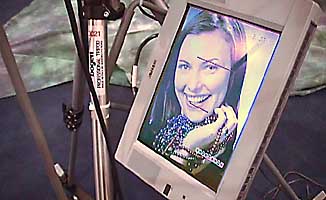 The
camera head produces an upright (portrait format image) when mounted
horizontally. There is no integral viewfinder - any video monitor can
be used. Sony were using a large flat-screen color LCD fixed to the
tripod. The camera is triggered using a hand-held wired remote
control. Like the best broadcast television cameras, the DKC-ST5 uses
three two-thirds inch 1.4 megapixel progressive scan CCD chips - one
each for red, green and blue - mounted on a prism block which
analyzes the light. The chips are mounted with diagonal spatial
offset, a technique which enables the resolution to be interpolated
to produce a 2,560 x 2,048 pixel image.
The
camera head produces an upright (portrait format image) when mounted
horizontally. There is no integral viewfinder - any video monitor can
be used. Sony were using a large flat-screen color LCD fixed to the
tripod. The camera is triggered using a hand-held wired remote
control. Like the best broadcast television cameras, the DKC-ST5 uses
three two-thirds inch 1.4 megapixel progressive scan CCD chips - one
each for red, green and blue - mounted on a prism block which
analyzes the light. The chips are mounted with diagonal spatial
offset, a technique which enables the resolution to be interpolated
to produce a 2,560 x 2,048 pixel image.
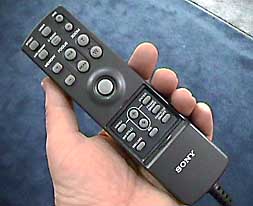
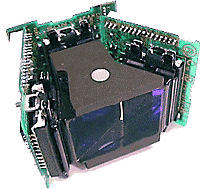
ISO settings from 20 through 160 are selectable, with electronic shutter speeds from 4 seconds to 1/10,000 - 1/15 to 1/10,000 with flash. Up to nine frames may be captured in a single burst, at a rate up to two frames per second.
Although the camera won the Professional Portrait award it is not limited to this role and would be suitable for many other commercial and scientific applications. But it is not portable and lacks the movements which many such photographers require of a studio view camera.
FILM SCANNER
Also from Sony was the UY-S77, a 2,200ppi 35mm and APS film scanner, which can scan 2,048 x 3,072 pixels in about nine seconds. It will pre-scan a whole roll of 36 exposure 35mm film in about 37 seconds. Intended for DTP and photo-finishing applications, the price is $7,500.
DIGITAL VIDEO
The lighting on the PMA show floor was a mixture of Sodium and Mercury vapor discharge, hardly the quality of light for good photography. The photographs which accompany this report were taken using a Sony DCR-PC7 digital video camera, acquired using Radius PhotoDV and FireWire as described in the February 1998 Seybold Report on Internet Publishing, Volume 2 Number 6, pages 15 - 21. Acquiring the images was an easy task, but correcting and balancing the color was a lengthy task. Even so, the value of the DCR-PC7 was enormous. Descriptions by the booth personnel accompanied pictures of the products on the tapes. It is an invaluable digital sound and vision notebook.
There are two slight disadvantages with the DCR-PC7. One is the 10-to-1 range zoom lens, which is not at its sharpest at the kind of wide lens apertures needed in low-light conditions. The other is exposure control, always automatic with only an 'AE lock' button to fix the exposure for tricky subjects, such as dark products on a light background.
This reporters' first 'must have' product from this show was therefore an answer to these problems in a very similar package: the new Sony DCR-PC10 camera.
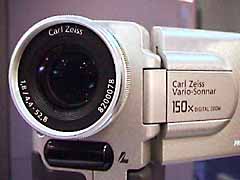 The
first improvement over the PC7 is a Vario Sonnar lens made by
world-leading German optical manufacturer Carl Zeiss, no less, who
make the lenses for Hasselblad and Contax cameras. The lens is a F1.8
12-to-1 optical range zoom, with a range of 4.4 - 52.8mm, compared
with 4.0 - 40mm in the PC7. Note that it says '150x digital zoom' on
the side of the camera. Forget this digital hype and stick to the
optical 12-to-1 range if you want to get the best out of this glass.
Our only wish is that Zeiss had been able to provide a wider lens
angle than previously, instead of slightly narrower. These cameras
need wide angle. Although screw-in adapters are available, they are
not very sharp.
The
first improvement over the PC7 is a Vario Sonnar lens made by
world-leading German optical manufacturer Carl Zeiss, no less, who
make the lenses for Hasselblad and Contax cameras. The lens is a F1.8
12-to-1 optical range zoom, with a range of 4.4 - 52.8mm, compared
with 4.0 - 40mm in the PC7. Note that it says '150x digital zoom' on
the side of the camera. Forget this digital hype and stick to the
optical 12-to-1 range if you want to get the best out of this glass.
Our only wish is that Zeiss had been able to provide a wider lens
angle than previously, instead of slightly narrower. These cameras
need wide angle. Although screw-in adapters are available, they are
not very sharp.
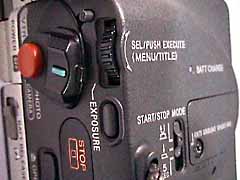 Coupled
with the new lens, Sony have introduced a manual exposure feature,
controlled by a button and thumb-wheel on the rear of the camera.
This button is like the 'EasyPilot' control on the Agfa ePhoto1280
camera - a clever combination of small selector wheel and push button
- also used for easier access to menu items. A new polycrystaline
silicon viewfinder ups the resolution from 113K pixels to 180K. Other
extras include six digital picture effects (mosaic, sepia,
monochrome, solar, negative art and pastel) and LaserLink wireless
playback to a TV receiver.
Coupled
with the new lens, Sony have introduced a manual exposure feature,
controlled by a button and thumb-wheel on the rear of the camera.
This button is like the 'EasyPilot' control on the Agfa ePhoto1280
camera - a clever combination of small selector wheel and push button
- also used for easier access to menu items. A new polycrystaline
silicon viewfinder ups the resolution from 113K pixels to 180K. Other
extras include six digital picture effects (mosaic, sepia,
monochrome, solar, negative art and pastel) and LaserLink wireless
playback to a TV receiver.
Price of the PC10 is the same as the PC7 it replaces: $2,899 - about $2,699 street. This is more expensive than in Europe. After shopping around I bought my PAL system PC7 by mail order in the UK for about $1,700 plus tax.
Other related Sony products were the DVBK-2000 PCI FireWire card (though Sony insist on calling it 'i.Link') with Digital Video (DV) still image capture. For both Mac and PC, it is priced at $699. Capture on the move is also catered for with the DVBK-CW200 (memorable, these Sony product numbers, aren't they?) PCMCIA FireWire card at $799. Sadly, it only works with PC.
PANASONIC & JVC INTRODUCE 'COMBINATION' CAMERAS
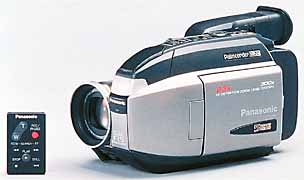 Panasonic
were claiming a new category with combined camcorders and digital
stills cameras. The hybrid video/640 x 480 pixel digital cameras
record video onto VHS-C cassettes and store 30 digital stills on 1MB
of internal memory. Panasonic have two models, the PV-858 with mono
viewfinder at $999.95 and the PV-L958 with color viewfinder at
$1099.95. They will become available in May 1998.
Panasonic
were claiming a new category with combined camcorders and digital
stills cameras. The hybrid video/640 x 480 pixel digital cameras
record video onto VHS-C cassettes and store 30 digital stills on 1MB
of internal memory. Panasonic have two models, the PV-858 with mono
viewfinder at $999.95 and the PV-L958 with color viewfinder at
$1099.95. They will become available in May 1998.
JVC launched the GR-AXM700 DualCam which captures digital images at the low resolution of 320 x 240 pixels. The camera can hold up to 44 standard JPEG digital images or 22 higher quality images. It will be available in April at $999.95
Although these hybrid cameras may hold a limited attraction for home use, where buying one camera makes better sense than buying two, we feel that such hybrids will be short lived when consumers realize that they get 30 stills every second from the video tape and all they need is a video capture device. For professional use, the quality advantage of DV is so great that that is the only video route we recommend.
JVC
JVC announced the GR-DVL9000 'Cybercam' digital camcorder with a claimed resolution of 500 lines (horizontal) by 480 lines (vertically) and a progressive scan CCD which eliminates dual-field picture jitter. The lens is a very fast F1.2 with a 10-to-1 optical range from 5 - 50mm. "Spline interpolation' is said to improve quality when the digital zoom extender is used. The camera has FireWire output and will be available in April at $2,799.95
VIDEO CAPTURE
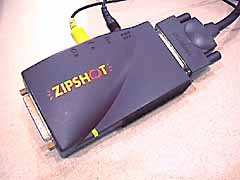 Other
companies have woken up to the capture of video, a market pioneered
at the affordable end by Play Incorporated with the 'Snappy'
device.
Other
companies have woken up to the capture of video, a market pioneered
at the affordable end by Play Incorporated with the 'Snappy'
device.
'Zipshot' from Arcsoft is one of the products which is giving Snappy a run for our money. It's a parallel port device with 25pin D connectors at each end, enabling it to be used in conjunction with other parallel devices, such as printers. One model will cover not only NTSC (US and Japan) but also PAL (Europe) and even SECAM (France and Russia). It will capture at up to 1,600 x 1,200 pixels but, as video signals just don't have that kind of resolution, it's like claiming a scanner with an optical resolution of 600ppi has a resolution of 4,800ppi because of interpolation. Zipshot is a self-powered device which costs only $129.
KODAK
NEW DCS520 PROFESSIONAL CAMERA
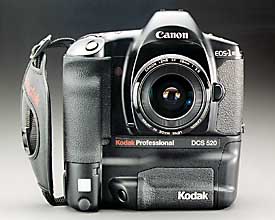
One of the real stars of the show was the new Kodak DCS520 camera, though its magnitude could and should have been much brighter.
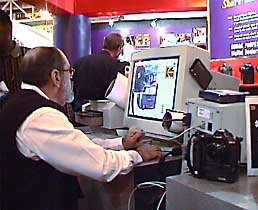 The
cramped Kodak professional booth was always a hive of activity but
demonstration of the DCS520 was left to a guy working at a
workstation, back to the audience, camera just perched on counter top
beside him with no prominence. We asked if this was the main showing
of the camera and were told that it was. We were handed a small stack
of prints, taken at the Winter Olympics in Nagano, to thumb through.
Apart from that, the only way to judge the camera was by having your
picture taken in the aisle, in the mixed discharge lighting of the
hall. Such photographs were surprisingly good in the circumstances
but, come on Kodak, it's time for more imagination than this. Learn
to shout your ground-breaking new products loudly from the rooftops.
We are not being negative, it's frustration. Kodak deserve - and need
- success for this camera but we've still to see it in action
producing high quality pictures.
The
cramped Kodak professional booth was always a hive of activity but
demonstration of the DCS520 was left to a guy working at a
workstation, back to the audience, camera just perched on counter top
beside him with no prominence. We asked if this was the main showing
of the camera and were told that it was. We were handed a small stack
of prints, taken at the Winter Olympics in Nagano, to thumb through.
Apart from that, the only way to judge the camera was by having your
picture taken in the aisle, in the mixed discharge lighting of the
hall. Such photographs were surprisingly good in the circumstances
but, come on Kodak, it's time for more imagination than this. Learn
to shout your ground-breaking new products loudly from the rooftops.
We are not being negative, it's frustration. Kodak deserve - and need
- success for this camera but we've still to see it in action
producing high quality pictures.
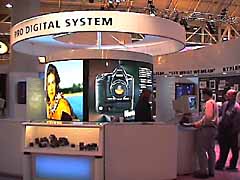 As
it turned out, this was not the main showing of the DCS520. Just
across the aisle a huge area was devoted to the camera and a
promotional video was being played loudly. This was the Canon booth.
Canon market the DCS520 as the EOS D2000. They are identical, except
for the name screen-printed on the front. Strangely, this part of the
Canon booth was quite empty whenever we passed by.
As
it turned out, this was not the main showing of the DCS520. Just
across the aisle a huge area was devoted to the camera and a
promotional video was being played loudly. This was the Canon booth.
Canon market the DCS520 as the EOS D2000. They are identical, except
for the name screen-printed on the front. Strangely, this part of the
Canon booth was quite empty whenever we passed by.
DC200
The DC200 is Kodak's third megapixel camera, producing 1,152 x 864 pixel images. Unlike the popular DC210, which has a zoom, the DC200 has a fixed focus lens equivalent to 39mm on a 35mm film camera. Like the DC210, the camera can fully process images in the camera, allowing users to import them directly into many applications. FlashPix and JPEG are supported and the camera has NTSC or PAL video output to enable images to be viewed on a TV. At a retail price of $599 the DC200 is very good value.
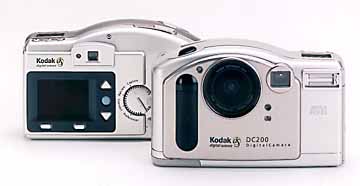
ADVANTIX FILM DRIVES
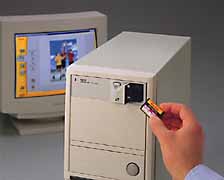 The
FD300 and FD500ix are compact 30-bit APS film scanners, small enough
to fit into a standard PC bay. Kodak have always specialized in fast,
productive scanners and these small scanners are no exception:
fifteen thumbnail images are produced in less than a minute. The
FD500ix model allows users to write customized reprint data, such as
crop, zoom, enlargement and quantity. This records on the 'IX'
(Information Exchange) magnetic coating on the back of the APS
film.
The
FD300 and FD500ix are compact 30-bit APS film scanners, small enough
to fit into a standard PC bay. Kodak have always specialized in fast,
productive scanners and these small scanners are no exception:
fifteen thumbnail images are produced in less than a minute. The
FD500ix model allows users to write customized reprint data, such as
crop, zoom, enlargement and quantity. This records on the 'IX'
(Information Exchange) magnetic coating on the back of the APS
film.
Both scanners will digitize an APS frame at 2,400ppi, producing 1,500 x 2,625 pixel images with a file size of about 12MB. Medium (1,600ppi) and low (800ppi) resolution scans are also possible. Scanned at the highest resolution, images would be suitable for high quality reproduction at up to half page size.
Connection, to PC only, is by a parallel interface cable. Prices are not yet available.
SCANNER UPDATES
Kodak also have a new PhotoCD Film Scanner 4050 for Macintosh with an improved dynamic range of 3.2. It can scan originals from 35mm to 4 x 5 inches at up to 4,098 x 6,144 pixels, producing files up to 72MB. Cost is $56,500.
Users of the RFS3570 can upgrade their scanners to give improved reliability, stability and speed. The upgrade includes a more efficient light source that does not require a color filter wheel and no IR filter, with a claimed improvement in color separation and control. An improved motherboard sends data from the scanner more quickly. Image processing is now carried out in the host computer, to take advantage of the increased processing power of today's PCs. It is claimed that scan times can be cut in half.
The upgraded scanner costs $15,000 but older RFS3570s can be factory-upgraded for $6,750.
IOMEGA
Iomega was a first-time company at PMA, one of a number of electronics companies making inroads into the previously exclusive domain of the photographic companies.
Iomega does not need any tips about how to make sure you remember them. They gave away little yellow clickers, which made the hall sound full of crickets. So wherever you went it was impossible to forget the Iomega Clik! drive. If you hadn't already been to the Iomega booth, you just had to ask someone what all the clicks were about. A simple but effective promotion. Full marks, Iomega.
CLIK!
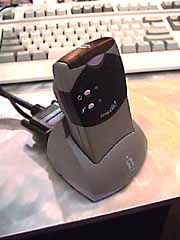
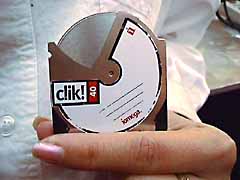 Clik!
uses a tiny cartridge, about two by two inches and only a twelfth of
an inch thick. This goes inside a small portable drive which can be
connected to digital cameras, PDAs, Palmtops, PCs etc. The format has
been endorsed by Hewlett-Packard and Kodak and others, so we may see
the drives built-into products. Three of the cartridges weigh a
little over an ounce, making Clik! an incredible portable storage
device. A Clik! will hold 40MB of data - almost as much as one of the
original SyQuests - and they are due to be released in the second
half of 1998 at a cost of $9.95 per cartridge or less.
Clik!
uses a tiny cartridge, about two by two inches and only a twelfth of
an inch thick. This goes inside a small portable drive which can be
connected to digital cameras, PDAs, Palmtops, PCs etc. The format has
been endorsed by Hewlett-Packard and Kodak and others, so we may see
the drives built-into products. Three of the cartridges weigh a
little over an ounce, making Clik! an incredible portable storage
device. A Clik! will hold 40MB of data - almost as much as one of the
original SyQuests - and they are due to be released in the second
half of 1998 at a cost of $9.95 per cartridge or less.
DOUBLE JAZ IN NEW ORLEANS
New Orleans is the Jazz capital and Iomega celebrated by doubling the capacity of its Jaz drives from 1 to 2GB. The new drives will be backward compatible with the original 1GB cartridges and the price of the 1GB drives have been cut from $399 to $299. Also available is a Jaz Jet Ultra SCSI cross-platform PCI card, said to be capable of speeds up to 20MB per second. Cost is $99.95.
THE BUZ
Could it be the profits of the highly successful Zip and Jaz drives which are bringing us other new ideas from Iomega? If so they are investing wisely.
Perhaps the coolest new product of the entire show was Buz, a comprehensive solution for capturing, editing and sharing video, digital stills and sound on your PC. It's a video capture and editing board, combined with an Ultra SCSI controller, which captures full motion video into the PC. Once in the PC, you can edit with simple-to-use software. A 'Buz Box' brings all the audio and video input and output connecting cables together at a neat connection hub. Video resolution is up to 720 x 480 pixels at 30fps (NTSC) or 768 x 576 pixels at 25fps (PAL/SECAM), 24 bit. Capture format is AVI, compression is Motion JPEG (MJPEG) and the video data rate is up to a sustained 6MB per second. Both composite and S-Video can be handled. Still images up to 720 x 480 pixels may also be captured. Buz comes bundled with MGI VideoWave SE Plus video software, PictureWorks HotShots for stills and Iomega Recordit for sound.
You would expect all this to cost a bundle too. In fact the hardware and software adds up to $199. No, we haven't missed the last nine off the price - $1,999 - the whole kit really does come for $199.
IMAGE AXS
Iomega Jaz drives come bundled with Digital Arts and Sciences' Image AXS software, an image database which will handle all your images, multimedia files and sounds. The bundled version is upgradeable to ImageAXS Pro, which also allows you to create portfolios and to export HTML pages for publication on the web.
ImageAXS Pro is said to be simple enough for an individual photographer to use, yet powerful enough to catalog all the images of the largest stock photo house in the world.